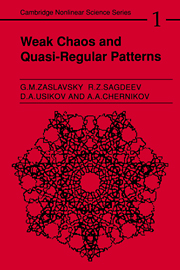10 - Patterns in art and nature
Published online by Cambridge University Press: 29 October 2009
Summary
So far, we have been discussing various kinds of pattern with regular or almost regular symmetry. They emerged either in phase space of dynamic systems or in coordinate space of hydrodynamic flows. Common to all these cases was the method of obtaining or revealing patterns. Such patterns emerged not as the result of some artificial formal algorithm but as an expression of natural laws. In ancient times, however, people did not possess the level of knowledge available to us today. Perhaps it was the attempt to penetrate into the laws of creation of regular patterns, that gave rise to the art of ornament. Or perhaps this form of human activity had nothing to do with what was observed in nature. In either event, it would be interesting to make a number of comparisons between ancient ornaments and the pictures drawn by the trajectory of a real particle under certain conditions.
Two-dimensional tilings in art
Byzantine mosaic is one of the oldest examples of symmetrical periodic tilings of a plane (Fig. 10.1.1). Although the periodicity condition might have arisen as an independent problem, practical aims of architectural design required exactly this kind of ornament. Tiles of one shape (or of several different shapes) were to form the elementary components of a tiling. The element of an ornament was to be reproduced as many times as need, so that eventually any chosen portion of the plane could be paved.
The ornamental technique reached its peak of development in Muslim art. Elementary cells of an ornament became far more complex (Figs. 10.1.2 to 10.1.4).
Information
- Type
- Chapter
- Information
- Weak Chaos and Quasi-Regular Patterns , pp. 211 - 231Publisher: Cambridge University PressPrint publication year: 1991
